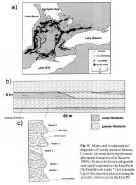|
Spec. Publ. Int. Ass. Sediment, 32 (2002),
167-93
ANALYSIS OF TERRESTRIAL HYPERCONCENTRATED
FLOWS AND THEIR DEPOSITS
M. BENVENUTI1 and I.P. MARTINI2
1Dipartimento
di Scienze della Terra, Universit¨˘ di Firenze, Italy
2Department of Land Resource
Science, University of Guelph, Ontario, Canada N1G 2W1
ˇˇ
 The term hyperconcentrated flow refers to
intermediate states between debris flows and fluid flows, where fluid turbulence
remains an important dispersal mechanism of clastic particles. Whereas the
end-member flows are fairly well understood, unanimous agreement has not been
reached on the subdivision and boundary characteristics of their deposits. This
paper briefly reviews the main characteristics of hyperconcentrated flows
resulting from either suspended-load hyperconcentration or bedload
hyperconcentration (traction carpet), and focuses on the analysis of three
deposits possibly associated with these flows. The first two deposits formed in
ancient, temperate alluvial fans of Pliocene-Pleistocene post-collision basins
of the Northern Apennines, Italy, and the third in Upper Pleistocene glacial
outwash of Ontario, Canada. The concentrated flows in terms of frequency,
magnitude and rheological properties of the flow. Recognition of
hyperconcentrated-flow deposits through facies analysis leads to a better
understanding of the developmental dynamics of alluvial sediment succession, and
provides powerful information for risk assessment of localities possibly
affected by hydrogeological hazards. The term hyperconcentrated flow refers to
intermediate states between debris flows and fluid flows, where fluid turbulence
remains an important dispersal mechanism of clastic particles. Whereas the
end-member flows are fairly well understood, unanimous agreement has not been
reached on the subdivision and boundary characteristics of their deposits. This
paper briefly reviews the main characteristics of hyperconcentrated flows
resulting from either suspended-load hyperconcentration or bedload
hyperconcentration (traction carpet), and focuses on the analysis of three
deposits possibly associated with these flows. The first two deposits formed in
ancient, temperate alluvial fans of Pliocene-Pleistocene post-collision basins
of the Northern Apennines, Italy, and the third in Upper Pleistocene glacial
outwash of Ontario, Canada. The concentrated flows in terms of frequency,
magnitude and rheological properties of the flow. Recognition of
hyperconcentrated-flow deposits through facies analysis leads to a better
understanding of the developmental dynamics of alluvial sediment succession, and
provides powerful information for risk assessment of localities possibly
affected by hydrogeological hazards.
|